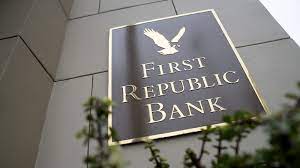A $30 billion rescue package for First Republic Bank was revealed by 11 of the largest U.S. banks on Thursday in an effort to keep it from failing as the third bank in less than a week and stave off a wider banking crisis.
The Silicon Valley Bank, which folded last week after depositors withdrew approximately $40 billion in a couple of hours, shared customers with San Francisco-based First Republic. On Sunday, the Signature Bank in New York was closed. First Republic, which had deposits of $176.4 billion as of December 31, seemed to be dealing with the same problems.
Several unnamed banks had experienced significant withdrawals of uninsured deposits, according to the group of banks that led the rescue effort. Up to $250,000 in deposits are insured for individual accounts by the Federal Deposit Insurance Corporation.
Even after the bank announced it had obtained fresh liquidity from JPMorgan and the Federal Reserve, Republic’s shares fell more than 60% on Monday.
The rescue plan brought back memories of the financial crisis of 2008 when banks flocked to the aid of weaker banks early on. In an effort to prevent the situation from getting worse, banks then quickly took over one another.
The $30 billion in uninsured deposits is viewed as a show of confidence in the First Republic, whose banking franchise was frequently the envy of the industry before the last week. The bank catered to wealthy customers, many of whom were billionaires, and provided them with favorable loan conditions. According to The Wall Street Journal, Mark Zuckerberg, the founder of Facebook, obtained a mortgage through the First Republic.
The price of First Republic shares rose on Thursday after falling as much as 36% earlier in the day on news that a rescue plan was being prepared. The stock gained 10% by closing.
JPMorgan Chase, Bank of America, Citigroup, and Wells Fargo have all agreed to contribute $5 billion in uninsured deposits to the First Republic as part of the aid package. Each of Goldman Sachs and Morgan Stanley will contribute $2.5 billion to the bank. BNY Mellon, State Street, PNC Bank, Truist, and US Bank would each contribute $1 billion toward the $5 billion total.
“The actions of America’s largest banks demonstrate their trust in the nation’s banking system,” the banks said in a statement.
Yet, Silicon Valley Bank failed because its closest and most devoted clients—venture capitalists and start-ups—left the bank at the first indication of danger, whereas the banks saved one of their rivals.
The banks declared, “We are putting our financial strength and liquidity into the bigger system, where it is most required.
The country’s banking watchdogs also released a statement applauding the rescue effort.
In a joint statement, Treasury Secretary Janet Yellen, Acting Comptroller of the Currency Michael Hsu, Federal Reserve Chair Jerome Powell, and FDIC Chairman Martin Gruenberg said: “This show of solidarity by a group of significant banks is highly welcome and underscores the resiliency of the banking system.
First Republic’s $30 billion investment is viewed as a safeguard against more bank runs. Last week, investors worried that depositors would withdraw their money and rush to the country’s largest banks; this led to a sharp decline in the share prices of numerous midsized institutions.
The federal government took action over the weekend to safeguard all of the banks’ deposits, including those that went over the FDIC’s $250,000 per individual account cap, in an effort to win back the public’s trust in the financial system. Although Silicon Valley Bank was the initial target of the financial crisis, regulators told reporters earlier this week that it eventually became necessary for the government to support the banking sector because it appeared that more runs would occur.

















